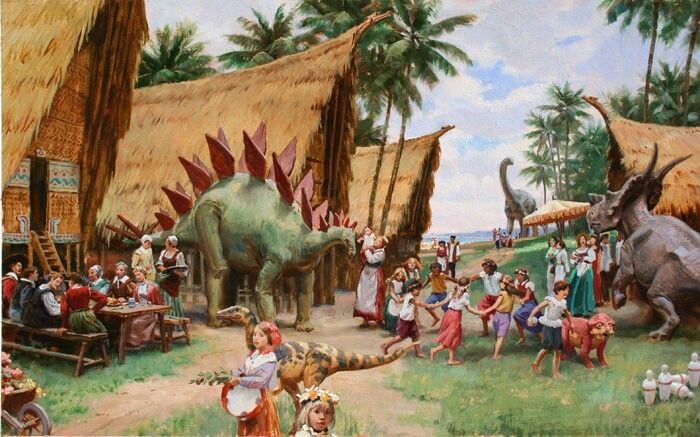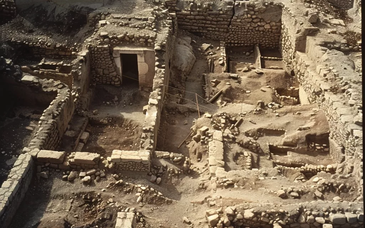
In the first two installments of this series we looked at figurines and drawings of dinosaurs which seemed out of place. More accurately, they seemed to be in the wrong time. The drawings and figurines were reportedly made hundreds of years before anyone should have known what a dinosaur looked like. In this installment we will change direction slightly and look briefly at reports of footprints in the rocks. There have been reports from multiple locations of dinosaur and human footprints being fossilized in the same rock. This would only be possible if the footprints were made very close to the same time, within a few days or weeks. If the reported footprints belong to dinosaurs and to humans it would be solid proof the two species co-existed at some point in time.
Paluxy River TracksThis type of proof is very important to certain creationists who believe in a literal interpretation of the Bible’s account of creation. They contend the seven days of creation were seven 24-hour days and thus the earth cannot be as old as science tells us. A key point in their argument is the case of dinosaurs which reportedly lived 65 million years ago. This time line does not fit with their interpretation of events and therefore any evidence which brings the age of dinosaurs and man together is critical to their argument. The young earth position is not new and some of its proponents make very sound arguments in defense of their beliefs. While evidence from many sciences are discussed by these various groups, the focus of this series is strictly on dinosaurs and the time line between their existence and that of man. With this in mind, do these dinosaur tracks reportedly being found next to human footprints offer solid scientific proof man and dinosaurs once shared the earth together?
The General Facts: There are reports from several locations where dinosaur and human footprints were found together. Due to space limitations we will look at only two of these. The first is located just outside of Glen Rose Texas at the Paluxy River. The site in question is specifically known as the Taylor Site, named after Stanley Taylor who examined the tracks first in 1968, then several more times to gather additional information. Taylor was a creationist and led a research group which examined the footprints and excavated a location not far from the Dinosaur Valley State Park. In 1973 Taylor released the film “Footprints in Stone” which closely examined the Paluxy River footprints.
There is no argument concerning the fact the area has a large number of dinosaur tracks preserved in the stone. It is clear many of the footprints were made by a biped dinosaur as it moved through the then muddy soil. The dispute comes in the examination of the alleged human footprints. The prints in question look undoubtedly like human footprints in both size and shape. The stride between prints is also consistent with a human and is on a different line than the confirmed dinosaur prints. From first impressions (no pun intended) the prints do seem to confirm man and dinosaur traveled through this area within a very short time frame. Critics of the human footprint theory believe all of the prints belong to the same species of dinosaur but were made at slightly different times. They believe the alleged human tracks are actually dinosaur tracks which became slightly eroded. This erosion, it is believed, removed the front portions of the print and may have altered the overall shape of the remaining area, leaving a partial dinosaur footprint rather than a human footprint.
The second site is literally around the world from Glen Rose Texas and is located in Turkmenistan. On a plateau near the village of Khodja Pil Ata an amazing series of dinosaurs tracks were discovered. In all more than 3,000 dinosaur tracks have been found to date. In 1983 the Moscow News reported the discovery of human footprints on this same plateau. Many considered the article in the then communist/atheist paper astounding. The plateau has the longest dinosaur trackways in the world, with more than 65 different species being represented within 31 different trackways. The entire plateau is approximately 1300feet by 980 feet in size. The largest dinosaur footprint on the plateau measures 28 inches with the smallest measuring at 8 inches.
Doctor Kurban Amanniyazov examined the trackways and estimated the rock to be 200 million years old. He confirmed the tracks in question were made either by a human, or a human like creature. The investigation centered around six distinct footprints which the team reported were clearly human. Other prints said to be human were also found in other areas of the plateau. Also found were fossilized goat tracks. These tracks have been identified as belonging to the Spiral Horned Goat which still lives in the area. Statements made by the investigators indicate they are perplexed by the apparent existence of human and goat footprints in the same rock as dinosaur prints. I could find no explanation from any of the investigators to explain the human tracks.
Key Evidence supporting Authenticity: The fact multiple tracks in multiple areas have been discovered lends support to the theory these are human footprints. While some explanations have been presented to explain the tracks and why they are not human, these explanations are not applicable to all the tracks in question and are not universally accepted as accurate for any of the tracks. The fact tracks, identical to modern day goats were also found in the Turkmenistan site also supports the claims of co-existence. The human prints in question definitely appear to be human in both size and shape and are in the same rock as the confirmed dinosaur tracks. Given the number of examples, these tracks are difficult to dismiss.
Key Evidence against Authenticity: In regards to the Taylor Site there is a great deal of debate even between creationists over the human prints. Some creationist researchers insist these are not human tracks and support the idea erosion altered the tracks. Still others insist the tracks are clearly human and present a wide assortment of evidence in support of their theory. When looking at the diagrams and examples showing the erosion theory it does appear to match the physical evidence, in most cases.The Turkmenistan site is much harder to dismiss. The area where the tracks are located is very remote and not easily reached for research. For this reason there have been a limited number of examinations of the tracks made and few opposing theories, or supporting evidence has been forthcoming. The scientists who have examined the tracks admit the tracks appear human and were made by humans, or a human like creature. Just what creature they may be referring to is unclear.
Conclusion:I find the erosion theory to be very plausible at the Taylor Site with the understanding it does not fully explain all of the apparent human tracks. The Turkmenistan tracks are much harder to make a decision about since so little research and material is available. The fact eye witnesses insist the tracks are definitely human in nature tends to tilt the scale, but without further evidence and investigation, a final determination is difficult.



